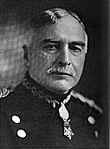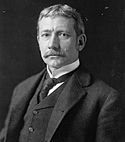Militia Act of 1903 facts for kids
The Militia Act of 1903 was an important law passed by the United States Congress. It is also known as the Efficiency in Militia Act of 1903 or the Dick Act. This law helped create the modern National Guard. It also clearly explained when the President could call the Guard into federal service. The act provided money from the government for equipment and training. This included paying for yearly summer training camps. The goal was for the new National Guard units to be organized and trained like the regular Army. They aimed to have the same training and readiness as active duty soldiers.
Contents
Why the Act Was Needed
For many years, the militia in each U.S. state operated under older laws from 1792 and 1795. These laws did not clearly say if the state or the federal government controlled the militia. Because of this, the federal government could not always count on the militias for national defense.
For example, during the War of 1812, some New York militia members refused to fight in Canada. They said their job was only to defend their home state. Another time, the Governor of Vermont tried to call his state's militia back from the Battle of Plattsburgh. He claimed it was against the law for them to fight outside of Vermont.
To solve this, the federal government started creating "volunteer" units when it needed more soldiers. These units were not part of the regular Army or the state militias. However, often entire militia units would volunteer together. This happened during the Mexican–American War (1846–1848) and the American Civil War (1861–1865).
During the Spanish–American War in 1898, more volunteer units were formed. One famous group was the "Rough Riders." The government also used National Guard units that volunteered as a whole.
Reforming the Army and the Dick Act
After the Spanish–American War, people saw problems with the National Guard. Units often lacked good training and were not ready for battle. Their organization, uniforms, and equipment were not the same across states.
Secretary of War Elihu Root and other military leaders wanted to improve the Army, including the National Guard. One of Root's supporters was Charles W. F. Dick. He was a Congressman from Ohio and later a Senator. Dick was also the head of the House Militia Affairs Committee. He had served in the Spanish–American War and was a longtime member of the National Guard. He became a major general leading the Ohio National Guard.
Dick strongly supported the Militia Act of 1903, which became known as the Dick Act. This new law replaced the older militia acts from 1795. It divided the militia into two groups:
- The Reserve Militia: All able-bodied men between ages 17 and 45.
- The Organized Militia: State militia units (the National Guard) that received money and support from the federal government.
The Dick Act provided $2 million to help National Guard units get modern equipment. It also allowed states to use federal money to pay for National Guard summer training camps. Each state's National Guard had to follow a set schedule of drills and annual summer training. The War Department also agreed to pay for Guard officers to attend Army schools. Regular Army officers would inspect and train National Guard units. The War Department also planned joint training exercises between the Regular Army and the National Guard.
In return, the federal government gained more control over the National Guard. The President of the United States could now call up the National Guard for up to nine months. This was to stop invasions, put down rebellions, or enforce federal laws. Guardsmen had to answer the President's call or face military trial. States had to organize, equip, and train their units like the Regular Army. If Guard units did not meet Army standards, they would lose federal recognition and funding.
The Dick Act helped solve the question of when the U.S. government could use the National Guard. However, federal authorities still could not order the National Guard to serve outside the United States.
Changes to the Act

The Dick Act was changed several times.
- The Militia Act of 1908 removed the nine-month limit on federal service. This gave the President the power to decide how long federal service would be. The rule against National Guard units serving outside the U.S. was also removed. However, the United States Attorney General later said that ordering the National Guard to serve overseas might be against the Constitution. The 1908 law also said that if the country needed more soldiers, the National Guard had to be called up before the Army could create new volunteer units. This law also created the Division of Militia Affairs. This was an Army office that oversaw federal training and rules for the National Guard.
- The National Defense Act of 1916 was passed before the U.S. entered World War I. It increased the number of required drill periods from 24 to 48 per year. It also made summer training camps longer, from five days to 15. The War Department could now plan the National Guard's size and types of units for each state. It could also set rules for how soldiers joined and how officers were appointed. Guardsmen had to take both state and federal oaths. This law replaced the federal money given to states with a yearly budget to cover most Guard costs, including pay for drills. The Division of Militia Affairs became the Militia Bureau (now the National Guard Bureau). The 1916 law solved the problem of sending National Guardsmen overseas. It said they would be discharged from their state militia and then drafted into federal service. This meant they were no longer state militia members when working for the federal government. This rule was used when the National Guard was called up for the Pancho Villa Expedition and again for World War I.
- Other changes included the National Defense Act of 1920 and the National Defense Act Amendments of 1933. The 1933 Act created a separate part of the United States Army called the National Guard of the United States. Since then, all National Guardsmen are members of both their State National Guard and the National Guard of the United States.
How the Act Was Used
The improvements to National Guard training and readiness, and the clear rules for federalizing them, led to the call-up of National Guard units. They served on the U.S.-Mexico border during the Pancho Villa Expedition.
National Guard units were also called into federal service and sent overseas during World War I.
The Dick Act and its changes improved the relationship between the Army and the National Guard. The Guard's successful service in the Villa Expedition and World War I showed its value. This helped John McAuley Palmer and other supporters of the National Guard. They were able to stop an effort in 1920 to replace the National Guard with a federal-only reserve force.
Challenges in the Southern United States
In some parts of the Southern United States, the way the Militia Act of 1903 was put into action reflected the racial segregation common at the time. This meant that African American citizens faced challenges. For example, some white militia units in the South refused to interact with black units from the North. Also, some governors would not allow black militia units from other states to take part in ceremonies held in their state.
Despite these challenges, African American units continued to serve where they were allowed. This included places like the District of Columbia, Maryland, Connecticut, Massachusetts, Ohio, Illinois, and New York.
In Fiction
The Militia Act of 1903 is mentioned in Jack London's 1908 novel The Iron Heel. In the book, it is described as being "rushed through Congress and the Senate secretly, with practically no discussion." The novel also says it introduced the draft for American citizens. It claims that if someone refused to join the militia or obey orders, they would be "tried by drumhead court martial and shot down like dogs."





